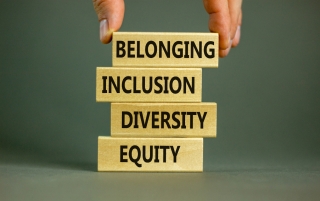
Diversity, Equity and Inclusion: Teaching Practices from two Culinary Instructors’ Perspectives
03 April 2023Inclusiveness across cultural, racial and socioeconomic levels leads to better student outcomes.
By Lisa Parrish, GMC Editor
Chef Thomas Meyer and Chef Marianne Albovias, Kendall College at National Louis University
Feedback & comments: This email address is being protected from spambots. You need JavaScript enabled to view it.
Student success is at the core of every culinary class dating back to the very first US culinary school, the Boston Cooking School founded in 1879. A student’s ability to learn, retain and perform these learned skills in a professional setting is a defining achievement for a culinary instructor. Even though student success continues to drive instructors, students and their needs have vastly changed since 1879. And culinary instruction has evolved in tandem.
Two instructors from Kendall College at National Louis University in Chicago have discovered developing a sense of belonging and inclusion in the classroom fosters better performance, attendance and cognition from today’s students. Chefs Thomas Meyer and Marianne Albovias believe the diverse student population currently enrolled in culinary institutions has changed the way instructors teach and how educational material is presented.
Chefs Meyer and Albovias will be sharing with Gold Medal Classroom readers their teaching methods that foster a sense of belonging and inclusiveness which directly leads to student success. For the next few months, read articles on how aspects of diversity, equity and inclusion have informed their successful teaching methods to produce students who learned, retained and performed culinary skills within and beyond the walls of Kendall College.
***************************************************
Inclusive and culturally responsive teaching concepts help students feel connected to the curriculum while exposing them to cultures beyond their own.
Imagine entering culinary school and being bombarded with a flurry of European and French culinary terms and techniques and not being familiar with many of the ingredients and dishes presented to you. While some students might find this exhilarating, others may feel disconnected or intimidated by the content.
Over the past few years, our classes have grown to include students coming from a variety of cultural, racial and socioeconomic levels. We have faced challenges in engaging students and found that fostering a sense of inclusion and belonging has helped to make students feel welcome, supported and seen. As a result, students are engaged and excited to participate in class. Below are examples of best practices techniques we have incorporated into our kitchen classes to help our students feel connected to the curriculum, while at the same time exposing them to diverse cultures and cuisines beyond their own.
The Inclusive Classroom concept refers to intentional approaches to curriculum, course design, teaching practice, and assessment that cultivate a conducive learning environment where students flourish when they feel valued, respected and supported.
In Breakfast Class, Chef Thomas Meyer produces a newsletter at the beginning of the quarter and posts it on the student web platform. The newsletter contains a welcome message, in addition to outlining the course. A discussion board is set up for students to introduce themselves and outline their goals. By initiating these discussions and introductions online before class begins, students have a more relaxed sense when entering the classroom on day one. This fosters a sense of welcomeness and belonging. Students feel safe and supported, knowing the institution and instructors care about who they are and want to learn about them.
The newsletter is updated weekly and open to students posting. In addition, the instructor has the opportunity to get to know the incoming students. The online/web-based platform is one that most students are comfortable using and gives the student who may be quiet or uncomfortable with public speaking an easier means of expression.
The Culturally Responsive Teaching concept centers around incorporating students’ cultural identities and lived experiences into the classroom as a tool for effective instruction (Education Week). In the culinary kitchen, we connect techniques or culinary concepts with students’ cultures to help give them a sense of pride and an opportunity to teach each other about their culture and family heritage. In turn, they take ownership, and it becomes a deeper learning experience.
In the Breakfast Class, students have this kind of opportunity. They discuss their personally created menu and agree on a production timeline. The students become responsible for creating and producing the menus and providing ingredient requisition lists and recipes. The recipes not only outline the methods of production but also provide some background about the menu items. The students’ menus must fit into the curriculum, and they must balance their time for mise en place with the regular classroom production responsibilities.
 Recently, several students of Asian descent worked together to produce a breakfast buffet consisting of a variety of traditional breakfast items from the Philippines and several China regions. Their classmates learned how to prepare these dishes, learned the dishes’ origin and importance, and (for many of the non-Asian students) had an opportunity to expand their palates. This type of learning environment leads to the Windows and Mirrors learning concept—creating lessons that reflect student experiences and provide them with insights into the experiences of others. Windows offer new views while mirrors offer reflections (Waterford.org).
Recently, several students of Asian descent worked together to produce a breakfast buffet consisting of a variety of traditional breakfast items from the Philippines and several China regions. Their classmates learned how to prepare these dishes, learned the dishes’ origin and importance, and (for many of the non-Asian students) had an opportunity to expand their palates. This type of learning environment leads to the Windows and Mirrors learning concept—creating lessons that reflect student experiences and provide them with insights into the experiences of others. Windows offer new views while mirrors offer reflections (Waterford.org).
Chef Marianne Albovias also incorporates the concepts of Culturally Responsive Teaching and Windows and Mirrors in the baking and pastry curriculum to make connections with students. In the Pastry Techniques course, there is a class dedicated to doughnuts. The curriculum includes a presentation of international doughnut types. Students then have the opportunity to choose and produce recipes of interest to them. From Greek loukimades, to Indian gulab jamun, to Korean mochi doughnuts, students learn the differences, but also the commonalities between these types of pastries. In the Foundations of Professional Baking class, traditional French recipes of pate a choux and brioche may be unfamiliar until our students make the connection that these recipes can be used to make churros and conchas.
These methods have helped engage our students. As our student population has changed and become more diverse, we can no longer rely on a “one size fits all” approach to curriculum and teaching techniques in the kitchen. Utilizing the concepts of diversity, equity and inclusion has helped students to feel a sense of belonging to the institution and that they are a contributing force in the classroom. These are only baby steps in this process, but by continuing to review our curriculum and educating our students in this manner, we ensure they will be successful culinary students and future successful culinary professionals.

